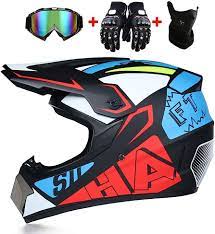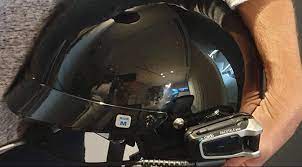Exploring the Benefits of Off-Road Helmets: Safety and Performance for Your Off-Road Adventures

Off Road Helmets: Protection and Performance
When it comes to off-road adventures, safety should always be a top priority. One essential piece of protective gear that every rider should invest in is an off-road helmet. Designed specifically for the demands of off-road riding, these helmets offer a combination of protection, comfort, and performance.
The Importance of Off Road Helmets
Off-road riding poses unique challenges compared to on-road motorcycling. The rugged terrain, unpredictable obstacles, and higher risk of falls make it crucial to have proper head protection. Off-road helmets are designed with specific features to address these challenges.
First and foremost, off-road helmets provide superior impact protection. They are constructed with a sturdy outer shell made from durable materials such as carbon fiber or fiberglass. This outer shell absorbs and distributes the force of impacts, reducing the risk of head injuries in case of accidents.
In addition to impact protection, off-road helmets also feature extended chin bars and visors. These components provide added protection for the face, preventing injuries from rocks, branches, or debris that may be encountered during off-road rides.
Comfort and Performance
Off-road riding can be physically demanding, requiring riders to navigate challenging terrains for extended periods. Off-road helmets are designed with comfort in mind to ensure riders can focus on their ride without distractions.
Ventilation is a key aspect of off-road helmet design. Riding off-road can be hot and sweaty work, but these helmets incorporate strategic vents that allow airflow while still maintaining optimal safety standards. This helps keep riders cool and comfortable even in intense riding conditions.
Another important feature of off-road helmets is their compatibility with goggles. Off-road riders often wear goggles to protect their eyes from dust, dirt, and debris. Off-road helmets are designed to accommodate goggles securely, ensuring a clear field of vision without compromising safety.
Choosing the Right Off Road Helmet
When selecting an off-road helmet, there are a few factors to consider. Firstly, ensure that the helmet fits properly. A well-fitting helmet should be snug but not overly tight, providing a secure and comfortable fit.
Look for helmets that meet safety standards such as DOT (Department of Transportation) or ECE (Economic Commission for Europe) certifications. These certifications indicate that the helmet has undergone rigorous testing and meets specific safety requirements.
Consider the type of off-road riding you will be doing. Different disciplines may have specific helmet requirements. For example, motocross helmets are designed for high-speed racing and offer additional features such as aerodynamics and enhanced ventilation.
Maintaining Your Off Road Helmet
To ensure your off-road helmet remains in optimal condition, regular maintenance is essential. Clean your helmet regularly using mild soap and water, avoiding harsh chemicals that could damage the materials.
Inspect your helmet for any signs of wear or damage before each ride. If you notice any cracks or significant impacts on your helmet, it’s important to replace it immediately, as compromised helmets may not provide adequate protection in case of an accident.
Lastly, store your off-road helmet in a cool and dry place away from direct sunlight when not in use. This helps preserve its structural integrity and extends its lifespan.
Ride with Confidence
An off-road helmet is more than just a piece of protective gear; it’s an investment in your safety as you embark on thrilling off-road adventures. By choosing a well-fitting, certified helmet and properly maintaining it, you can ride with confidence, knowing that you have the necessary protection to tackle any off-road challenge that comes your way.
Five Essential Tips for Selecting the Ideal Off-Road Helmet
- Choose a helmet with proper certification, such as ECE or DOT, to ensure safety.
- Look for a helmet with good ventilation to keep you cool during off-road rides.
- Consider the weight of the helmet; lighter helmets offer better comfort and reduce fatigue.
- Opt for a helmet with a removable and washable liner for easy maintenance and hygiene.
- Make sure the helmet fits snugly on your head without being too tight or too loose.
Choose a helmet with proper certification, such as ECE or DOT, to ensure safety.
When selecting an off-road helmet, it is crucial to choose one that has the proper certification to ensure your safety. Look for helmets that meet standards such as ECE (Economic Commission for Europe) or DOT (Department of Transportation). These certifications indicate that the helmet has undergone rigorous testing and meets specific safety requirements. By opting for a certified helmet, you can have peace of mind knowing that it has been designed and tested to provide optimal protection during off-road adventures.
Look for a helmet with good ventilation to keep you cool during off-road rides.
When selecting an off-road helmet, one important tip to keep in mind is to look for a helmet with good ventilation. Off-road riding can be physically demanding and often takes place in hot and sweaty conditions. Having a helmet with strategic vents allows for proper airflow, keeping you cool and comfortable throughout your off-road adventures. By choosing a helmet that prioritizes ventilation, you can focus on your ride without the discomfort of excessive heat, ensuring an enjoyable and refreshing experience on the trails.
Consider the weight of the helmet; lighter helmets offer better comfort and reduce fatigue.
When selecting an off-road helmet, it’s important to consider the weight of the helmet itself. Opting for a lighter helmet not only enhances comfort but also helps reduce fatigue during long rides. Off-road adventures can be physically demanding, and a heavy helmet can add unnecessary strain on the neck and shoulders. By choosing a lightweight off-road helmet, riders can enjoy improved comfort, allowing them to focus on their ride without feeling weighed down. So, when browsing for the perfect off-road helmet, keep in mind that lighter helmets offer better comfort and help minimize fatigue, ensuring an enjoyable and energizing riding experience.
Opt for a helmet with a removable and washable liner for easy maintenance and hygiene.
When selecting an off-road helmet, it is advisable to opt for a model that features a removable and washable liner. This convenient feature ensures easy maintenance and promotes good hygiene practices. Off-road riding can be intense and sweaty, so being able to remove the liner and give it a thorough cleaning helps keep the helmet fresh and free from unpleasant odours. Additionally, a removable liner allows riders to customize the fit of their helmet by replacing or adjusting the padding as needed. Prioritizing a helmet with a removable and washable liner not only enhances comfort but also contributes to the longevity of your gear, ensuring it remains in top condition for many off-road adventures to come.
Make sure the helmet fits snugly on your head without being too tight or too loose.
When it comes to off-road helmets, one crucial tip to remember is to ensure a snug fit without being too tight or too loose. A well-fitting helmet provides optimal protection and comfort during off-road rides. If the helmet is too tight, it can cause discomfort and restrict movement, while a loose helmet may not provide adequate protection in case of an accident. Finding the right balance ensures that the helmet stays securely in place, allowing you to focus on your ride with confidence and peace of mind.


